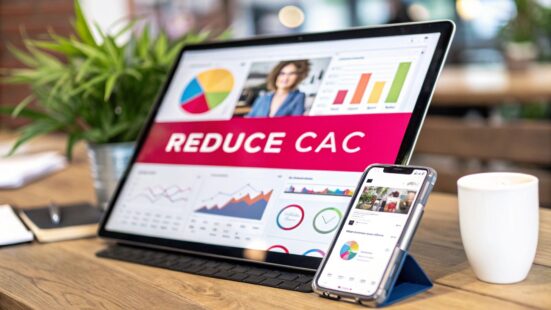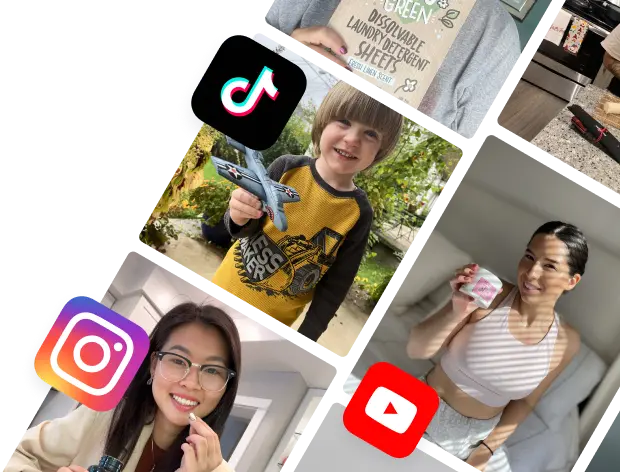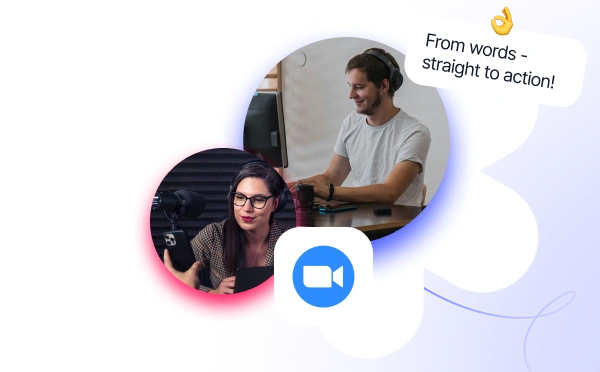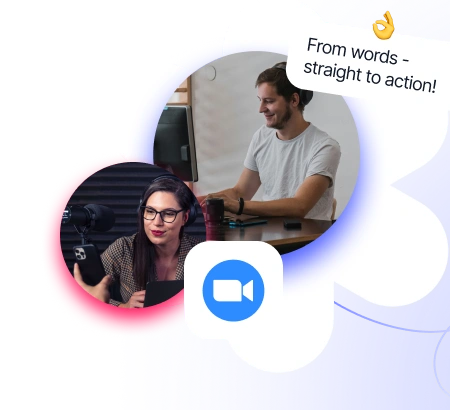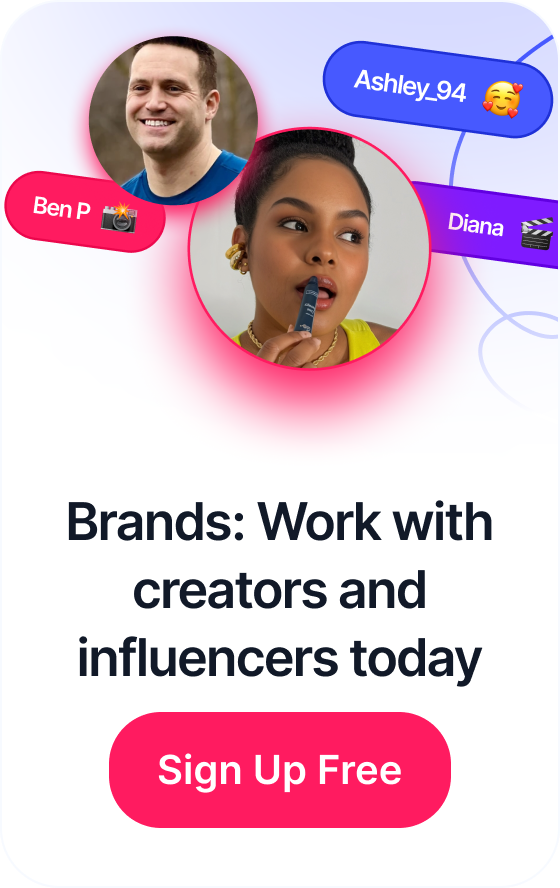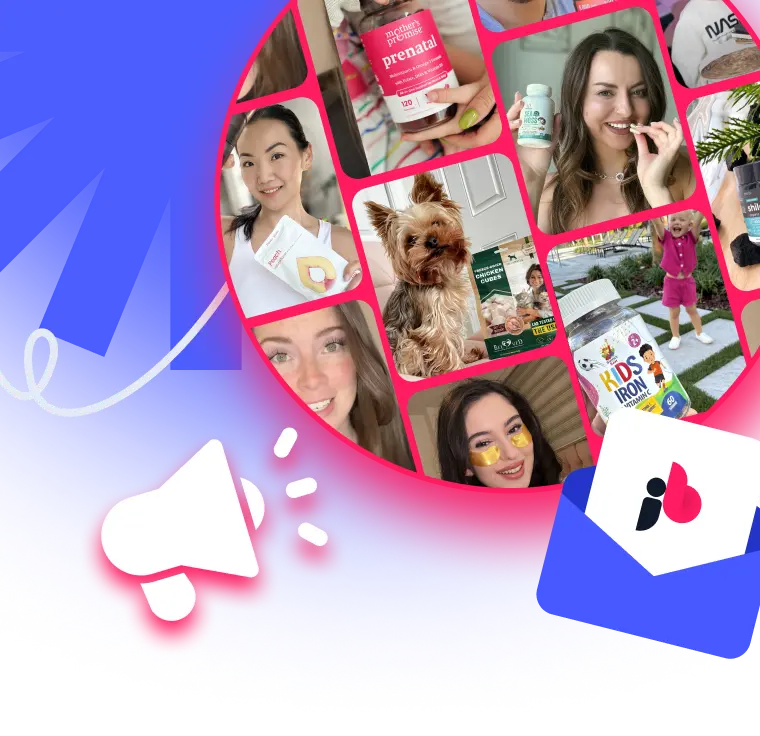 How Is Reach Calculated and Actually Measured
How Is Reach Calculated and Actually Measured
Let's be honest, soaring ad costs and cutthroat competition can make finding new customers feel like you're running on a hamster wheel. It's exhausting. But you can absolutely lower your customer acquisition cost (CAC) by getting smarter, not just spending more.
The secret isn't some magic bullet; it's about focusing your efforts in four critical areas: leveraging AI for laser-focused targeting, optimizing your entire customer funnel, championing authentic user-generated content, and letting hard data drive your campaign decisions. This isn't about finding temporary discounts—it's about building a sustainable, efficient growth machine.
Table of Contents
Why Your Customer Acquisition Cost Is So High

If you've noticed your CAC creeping up, you’re definitely not alone. Between 2014 and 2019, the average CAC shot up by nearly 60%. This spike was fueled by crowded digital ad spaces and more brands fighting for the same eyeballs. While selling online has opened up new doors, the core challenge is the same as it's always been: how do you bring in quality customers without blowing your budget?
This guide cuts through the generic advice to give you a real-world playbook. We're focused on building a cost-effective acquisition engine that actually scales with your business, making every marketing dollar work harder for you.
Getting to the Root of the Problem
A common mistake I see is businesses throwing more money at channels that are already underperforming, just hoping for a miracle. That strategy almost never works. It just leads to an inflated CAC and quickly diminishing returns.
The issue isn't always about spending less; it's about spending smarter. To make a real dent in your CAC, you have to get intimate with your customer journey, plug the leaks in your funnel, and then go all-in on what's actually working.
But first, you need to know your numbers cold. Before you can improve your CAC, you need a rock-solid baseline. Our detailed guide on https://joinbrands.com/blog/customer-acquisition-cost-calculation/ walks you through getting that number right.
The Blueprint for Sustainable Growth
A long-term, sustainable framework for keeping acquisition costs low is built on a few powerful pillars. These aren't quick hacks; they're strategic shifts that create lasting value and efficiency.
- Smarter Targeting: Use AI and predictive analytics to find high-intent leads and get in front of them before your competition even knows they exist.
- Funnel Optimization: Methodically analyze every single step of the customer journey to remove friction points and boost conversion rates.
- Authentic Advocacy: Build trust with real user-generated content and influencer partnerships that feel genuine, because they are. This resonates way more than polished, traditional ads.
- Data-Driven Refinement: Stop guessing. Continuously test and optimize your campaigns based on real performance data.
When you master these four areas, you stop just "buying" customers and start building a predictable system that attracts them. That’s the real difference between a short-term sales spike and long-term, profitable growth.
To give you a head start, we've broken down these strategies into a quick reference table.
Core Strategies to Reduce CAC At a Glance
Here’s a quick overview of the key strategies we'll be diving into, highlighting their primary goal and expected impact on your acquisition costs.
| Strategy | Primary Goal | Potential Impact on CAC |
|---|---|---|
| Smarter Targeting | Increase lead quality and focus ad spend on high-intent audiences. | Significant reduction through less waste. |
| Funnel Optimization | Improve conversion rates at every stage of the customer journey. | Moderate to significant reduction. |
| Authentic Advocacy | Build trust and social proof through UGC and influencer marketing. | Significant long-term reduction. |
| Data-Driven Refinement | Continuously improve campaign performance based on real-time data. | Consistent, incremental reduction. |
By keeping these core ideas in mind, you'll be better equipped to implement the detailed tactics that follow.
For a deeper dive into more tactics, check out this guide on proven ways to reduce customer acquisition cost. It offers some great additional perspectives that complement the methods we'll cover here.
Use AI and Predictive Analytics to Sharpen Your Ad Spend
Throwing money at ad campaigns and just hoping for the best is a surefire way to drive up your customer acquisition cost. It’s the old-school “cast a wide net” approach, and frankly, it’s inefficient. Today, we can do better by using AI and predictive analytics to target promising leads with incredible precision.
Think of it this way: traditional advertising is like fishing with a giant net. Sure, you catch some of what you want, but you also haul in a ton of junk, wasting time, energy, and money. AI is more like a high-tech fish finder that shows you exactly where the prize fish are swimming, so you only cast your line where it counts.
Automate Bidding with AI-Powered PPC
One of the quickest ways to see a real impact is with AI-powered bidding in your PPC campaigns. Platforms like Google Ads have smart bidding strategies that automatically adjust your bids in real time, all based on how likely a user is to actually convert. It's designed to stop you from overpaying for clicks that lead nowhere.
For example, an e-commerce store selling high-end running shoes can let the AI bid more aggressively for a user who has already visited specific product pages, watched review videos, and is now searching for "best marathon running shoes." On the flip side, the AI will bid much lower for a user who just bounces off the site, making sure your budget is spent on people who are ready to buy.
This isn't about setting your budget and walking away. It's about letting a smart algorithm make thousands of micro-decisions every second, each one aimed at boosting your return on ad spend (ROAS) and pushing your CAC down.
Find Your Best Leads with Predictive Scoring
Beyond just bidding, predictive lead scoring is a complete game-changer. Instead of treating every single lead as equal, an AI algorithm digs into your historical data to score each new prospect on their likelihood to convert. This gives your marketing and sales teams a clear roadmap of where to focus their energy.
Picture a SaaS company getting hundreds of free trial sign-ups every day. A predictive model can instantly analyze things like:
- Company Size: Do they fit your ideal customer profile (ICP)?
- Job Title: Is this person a decision-maker or just kicking the tires?
- In-App Behavior: Did they dive into key features or invite teammates to the platform?
- Engagement: Are they opening your onboarding emails?
Based on these factors, the AI can flag a lead from a 500-person company who invited three colleagues as a "hot lead," while a solo user from a tiny business who never logged back in gets a low score. Your sales team knows exactly who to call first, making them way more efficient and cutting the cost of acquiring each new customer. This kind of strategic focus is a key part of smart digital marketing budget allocation, as it stops you from wasting resources on dead ends.
Create Adaptive and Dynamic Audience Segments
Let's be honest, manual audience segmentation takes forever and is usually based on old assumptions. AI tools, however, can build adaptive audience segments that change and evolve right alongside customer behavior. This means your messaging is always hitting the mark. It’s a huge leap from basic demographics to truly nuanced, behavior-driven groups.
For instance, a subscription box service can use AI to automatically group customers who consistently buy "vegan-friendly" add-ons. The system can then serve them ads featuring new plant-based products without anyone on your team lifting a finger. The relevance goes up, and so do conversion rates.
The results speak for themselves. Businesses in e-commerce and SaaS that have adopted AI are reporting reductions in CAC by as much as 50% by 2025. This isn't some far-off concept; it’s happening right now by optimizing targeting and automating outreach with pinpoint accuracy. For a deeper look at the numbers, you can find more customer acquisition cost statistics on amraandelma.com. These are real, accessible tools you can use today to build a leaner, more effective way to win new customers.
Optimize Your Customer Funnel for Efficiency
If your customer acquisition cost is creeping up, chances are your funnel is leaking money. Think of it like a plumbing system with a bunch of tiny, invisible cracks. A small drip here and there might not feel like a big deal, but over time, all those drips add up to a serious loss. Plugging these leaks means taking a hard, methodical look at every single stage of your customer's journey.
The goal here is to pave a smooth road from the very first time someone sees your brand to the moment they click "buy." Every bit of friction you remove is one less reason for a potential customer to drop off. When each stage is humming along efficiently, you convert more of the leads you already paid for, which is the most direct way to bring your CAC down.
Plug Leaks at the Top of the Funnel
The top of your funnel is where you make your first impression, and frankly, it's often the leakiest part. This is where you grab attention with your ads, social media posts, and content. One of the biggest leaks I see all the time is a glaring mismatch between the ad creative and the landing page it leads to.
Imagine a skincare brand running a killer TikTok ad for a "50% Off Vitamin C Serum" offer. A user gets excited, clicks the ad, and… lands on the generic homepage. Now they're confused. They have to hunt for the serum, the discount isn't obvious, and they get frustrated and bounce. You just paid for a click that went absolutely nowhere.
To fix this, you need to achieve absolute message match between your ad and your landing page.
- Consistent Headlines: Your landing page headline has to echo the promise made in the ad. No exceptions.
- Mirrored Visuals: Use the same (or very similar) imagery, colors, and branding. It should feel like a seamless transition.
- Clear Call-to-Action: The button on the landing page should directly reflect the ad's CTA, like "Claim My 50% Off."
This kind of alignment builds instant trust. It reassures visitors that they're in the right place, which will slash your bounce rates and stop you from burning through your ad spend.
Nurture Prospects Stuck in the Middle
Look, not everyone who shows a flicker of interest is ready to buy on the spot. The middle of the funnel is all about nurturing these prospects, but this is where so many businesses just let them go cold—a huge waste of the money you spent to get them there in the first place. This is where targeted email sequences and smart retargeting campaigns become your best friends.
For instance, someone who downloaded your ebook on "Choosing the Right Project Management Software" is clearly interested, but they're still in the research phase. Don't hit them with a hard sell right away. Instead, drop them into a tailored email sequence.
- Email 1 (Day 1): Deliver the ebook and pull out one super-helpful tip from it.
- Email 2 (Day 3): Send them a case study of a similar company that solved their exact problems using your software.
- Email 3 (Day 5): Invite them to a free webinar where you demo key features that solve common pain points.
This approach keeps your brand top-of-mind by actually providing value, not just sales pitches. You're gently guiding them through their decision-making process, making it far more likely they’ll choose you when they're finally ready to pull the trigger.
Streamline the Bottom of the Funnel
The bottom of the funnel is the final hurdle—the checkout or sign-up flow. Losing a customer at this stage is the most painful because they were seconds away from converting. The number one culprit here is almost always friction. A clunky, multi-step checkout process with unexpected fees is a guaranteed conversion killer.
To nail this stage, make the process ridiculously simple.
- Remove unnecessary fields: Do you really need their phone number and date of birth for a digital download? Probably not.
- Offer guest checkout: Don't force people to create an account before they can give you their money. It's a massive roadblock.
- Be transparent about costs: Show all shipping fees and taxes right upfront. Nobody likes sticker shock right before they pay.
Today’s consumers interact with brands across dozens of touchpoints before making a purchase. You have to map out and understand this complex journey. For industries like fashion and electronics, 2025 benchmarks show average CACs between $66 and $76 per customer. The companies that regularly audit their funnels and use multi-touch attribution are the ones that can sustainably lower these costs and boost their marketing ROI. You can find more insights on the average customer acquisition cost on usermaven.com.
By using AI-driven tools, you can analyze user data to predict their next move and automate smart bidding strategies. This infographic breaks down the flow of how AI turns raw data into efficient ad spend.
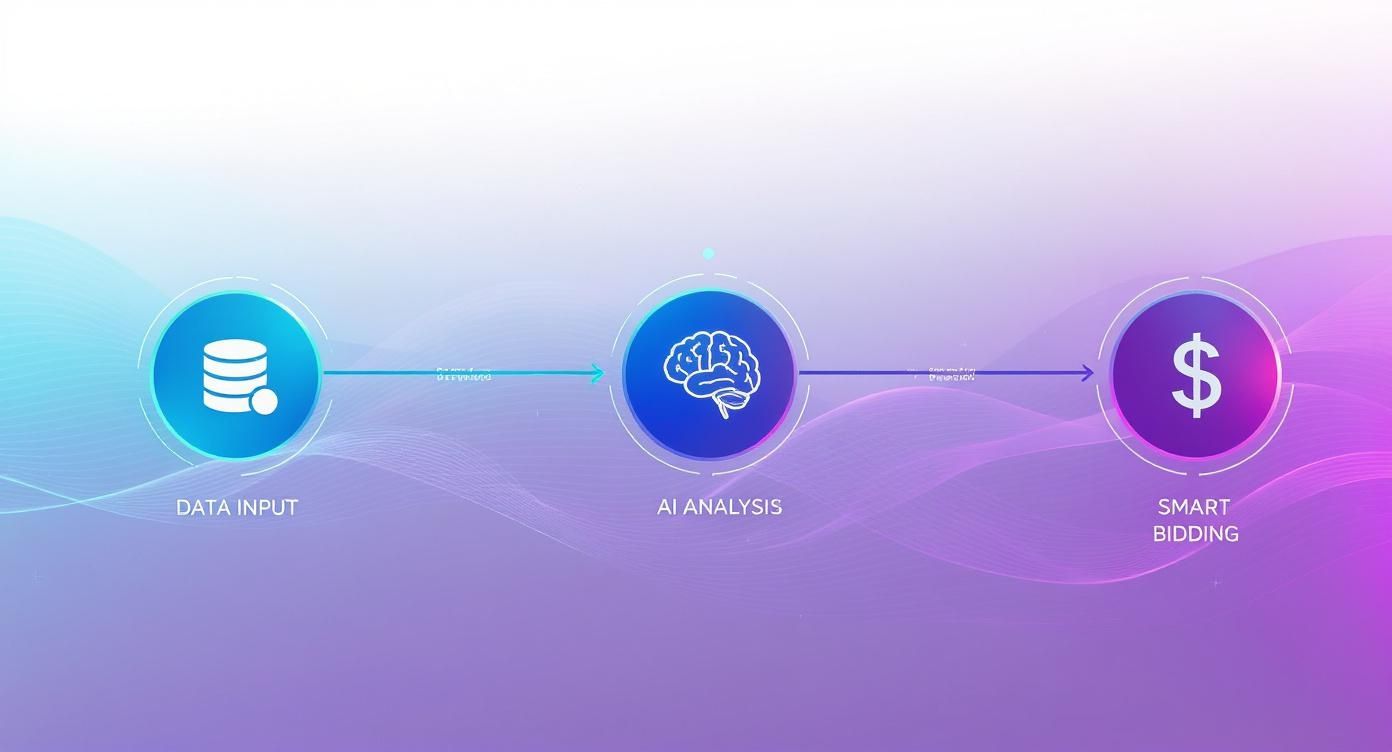
This process really shows how AI analyzes raw user data to make intelligent, real-time bidding decisions, making sure your budget is always being spent on the most promising conversions.
Let Your Fans Do the Talking with User Content and Influencer Marketing
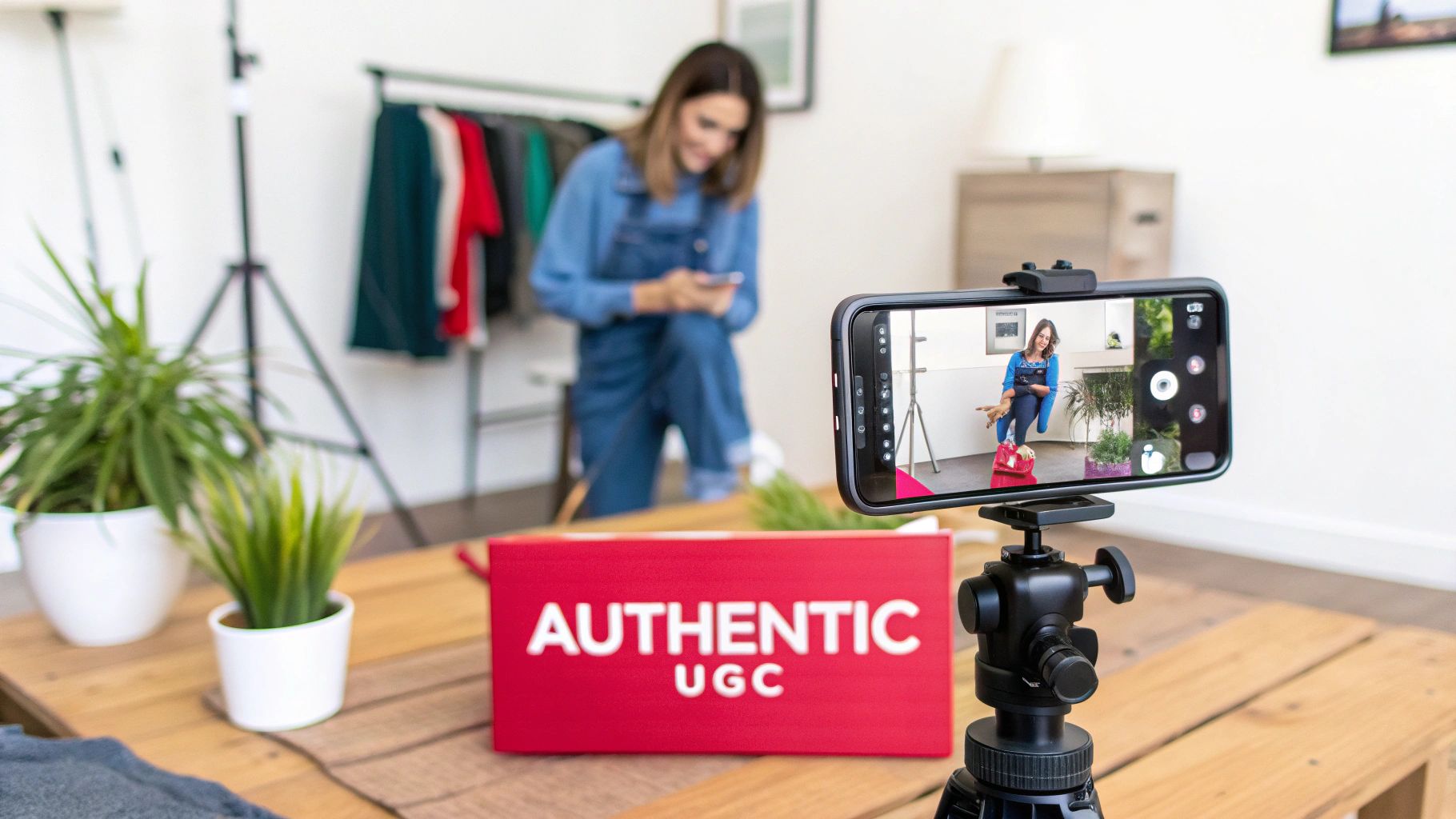
In a world drowning in polished, corporate ads, the most powerful and budget-friendly marketing tool you have is authenticity. Seriously. Instead of spending a fortune shouting about how great your products are, what if you could get your happiest customers and trusted creators to do it for you?
This is exactly what user-generated content (UGC) and influencer marketing are all about. These strategies aren't about flashy, top-down campaigns. They're about building real social proof that connects with how people actually buy things today.
When a potential customer sees a real person—not a faceless brand—genuinely loving your product, their trust shoots through the roof. And when that happens, your need to pour money into expensive paid ads drops right off.
Create a Machine for User-Generated Content
Let's be clear: user-generated content is any content—photos, videos, reviews, TikToks—that your actual customers create. It’s the modern-day version of word-of-mouth, and it works. Ads that feature UGC can see a 4x higher click-through rate compared to the glossy, studio-shot stuff.
The best part? You don't need a massive budget to make this happen. It all starts with making it incredibly easy and rewarding for your customers to share their excitement.
- Launch a Branded Hashtag: Come up with a simple, memorable hashtag for customers to use when they post. Then, make a point to feature the best submissions on your official channels. The recognition alone is a huge incentive.
- Run Contests and Giveaways: A little friendly competition goes a long way. Offer a prize for the best photo or video of the month to spark a wave of fresh content you can use for weeks.
- Automate Your Ask: Set up a post-purchase email that goes out a few weeks after delivery. In it, ask customers to share a photo of their new item for a chance to be featured or to snag a small discount on their next order.
A quick but critical tip: always get permission before you repurpose a customer's content for your official marketing. A simple DM asking for the okay or a checkbox on a submission form is usually all you need. It’s a small step that respects your customers and protects your brand.
Once you have this content, use it everywhere. Sprinkle it on your product pages, drop it into your email newsletters, and run it as paid social ads. This creates a constant supply of creative that feels real, builds trust, and ultimately pushes your CAC down. Getting good at sourcing and using https://joinbrands.com/blog/user-generated-videos/ is especially smart, since video drives incredible engagement.
Partner with Micro-Influencers Who Have Real Clout
Forget about dropping five or six figures on a celebrity influencer. The real value for most brands lies with micro-influencers—creators who typically have between 10,000 and 100,000 followers. Their audiences might be smaller, but they are often super niche and fiercely loyal, meaning their recommendations carry serious weight.
The secret to lowering your CAC with influencers is to ditch the big, one-off payments. Instead, build performance-based partnerships that scale with your success.
Ditch Big Fees for Smarter Partnerships
Instead of paying for a single sponsored post, think about building genuine, long-term relationships that are a win-win. This mindset is at the heart of any solid organic social media plan.
| Partnership Model | How It Works | Why It Lowers CAC |
|---|---|---|
| Product Seeding | Send free products to a handpicked list of influencers—no strings attached. | You get organic shout-outs from creators who genuinely love what you sent, creating powerful and authentic social proof. |
| Affiliate Programs | Give creators a unique discount code or link to share, and they earn a commission on every sale they drive. | You only pay for what works. It’s a zero-risk, performance-based channel that ties spend directly to sales. |
| Commission-Based | Negotiate a fee that’s paid out only when an influencer's content hits a specific sales or sign-up goal. | This model directly links your marketing spend to results, guaranteeing a positive return on your investment. |
By leaning into these models, you turn influencer marketing from a fixed cost into a variable one that’s directly tied to revenue. You stop paying for vague "exposure" and start paying for actual customers.
For anyone serious about slashing ad spend, digging into a good organic social media marketing playbook can uncover more strategies for getting customers without boosting every post. This approach turns creators from one-time advertisers into true brand partners, building a powerful and incredibly cost-efficient engine for growth.
Make Your Campaigns Smarter with Data-Driven Decisions
Your marketing data is a goldmine. Seriously. Buried inside are the exact coordinates telling you where to find high-value customers for a fraction of what you’re currently spending. But if you're not actively digging in and acting on that data, you're just leaving money on the table.
Continuous campaign optimization isn't about making massive, sweeping changes overnight. It's about a series of small, intelligent tweaks based on real performance. This is how you systematically chip away at your customer acquisition cost until it becomes a lean, mean, efficient machine.
Go Way Beyond Basic A/B Testing
When most people hear "A/B testing," their minds immediately jump to landing page headlines. That's a great start, but it’s barely scratching the surface of what’s possible. To truly move the needle on your CAC, you need to apply this testing mindset to every single piece of your campaigns.
Let's say you're running a Facebook ad campaign. Instead of just testing one landing page against another, you can—and should—create multiple variations of the entire ad experience.
- Test your ad creative: Pit a static image against a short video. See if a raw customer testimonial outperforms a polished product shot. You might be surprised.
- Experiment with ad copy: Try a question-based headline versus a direct statement. Does long-form copy work, or does a short, punchy version get the click?
- Vary your calls-to-action (CTAs): Is "Shop Now" converting better than "Learn More"? Maybe "Get 20% Off" is the real winner. Test it.
By isolating and testing these individual elements, you can pinpoint exactly what resonates with your audience. I've seen a simple change in an ad’s creative lead to a massive lift in click-through rates, which directly lowers your cost per click and, ultimately, your CAC.
Focus on Metrics That Actually Matter
It's way too easy to get lost in a sea of marketing data. Clicks, impressions, and likes might feel good, but they are often vanity metrics. They look nice on a report but tell you nothing about your bottom line.
To effectively cut down your customer acquisition cost, you have to shift your focus to the metrics directly tied to revenue and profitability.
The goal isn't just to get cheap clicks; it's to acquire profitable customers. This means you need to track metrics like Cost per Conversion and Return on Ad Spend (ROAS) with a relentless focus.
Setting clear conversion goals is the first step. A "conversion" doesn't always have to be a final sale. It could be a lead form submission, a free trial sign-up, or even a newsletter subscription. Once you define what a conversion is for each campaign, you can accurately measure how much it costs to get one.
Ruthlessly Optimize Your Channel Mix
Here's a hard truth: not all marketing channels are created equal. What works brilliantly on Google Ads might completely flop on TikTok, and vice versa. One of the biggest mistakes I see is brands spreading their budget evenly across channels without looking at what’s actually performing.
Channel optimization is all about digging into your analytics to find the winners and losers. You need to get in there and ask the tough questions:
- Which channel brings in customers with the highest lifetime value (LTV)?
- Which channel has the lowest cost per conversion?
- Where is my ROAS the highest?
Imagine you discover your LinkedIn ads have a high cost per click but are bringing in large enterprise clients with a massive LTV. At the same time, your Twitter ads get tons of cheap clicks but almost never convert into paying customers.
The data-driven decision here is a no-brainer: reallocate the budget you were wasting on Twitter and double down on your high-performing LinkedIn campaigns. This strategic shift ensures your money is working as hard as possible to acquire customers who will actually grow your business.
To help you get started, I've put together a simple checklist to prioritize your A/B testing efforts for the quickest wins.
A/B Testing Priority Checklist
This isn't an exhaustive list, but it’s a fantastic starting point. Use this as a guide to focus your testing on the elements most likely to influence conversion rates and drive down your acquisition costs fast.
| Testing Element | Why It Matters | Example Test |
|---|---|---|
| Call-to-Action (CTA) | The CTA is your final instruction to the user. Tiny changes in wording can have a huge psychological impact on their decision to click. | Test "Get Your Free Trial" vs. "Start for Free." The second option often feels lower commitment and can boost sign-ups. |
| Headline | This is the very first thing a user reads. It has to grab their attention instantly and clearly state your value proposition. | Test a benefit-driven headline (e.g., "Save 10 Hours Every Week") against a feature-driven one to see what resonates. |
| Ad Creative (Image/Video) | Visuals are processed much faster than text and are absolutely critical for stopping the scroll on social media. They make or break your ad. | Test a video of your product in action against a high-quality lifestyle image featuring a person. The results can be night and day. |
| Landing Page Layout | The structure of your page guides a user's eye and can make the conversion process feel either intuitive or confusing. | Test a clean, single-column layout against a two-column design to see which one reduces friction and lowers bounce rates. |
This repeatable process—test, measure, reallocate—is the key. It transforms campaign management from a game of guesswork into a data-backed science for steadily crushing your customer acquisition cost.
Got Questions About Cutting Your CAC? We've Got Answers
Diving into customer acquisition cost can feel like you're trying to solve a puzzle. The pieces are always shifting, and what works for one brand might be a total flop for another. Let's tackle some of the most common questions marketers ask when they start getting serious about lowering their CAC.
What Is a Good Customer Acquisition Cost?
This is the million-dollar question, isn't it? The honest answer is: it completely depends on your business model. There's no magic number for a "good" CAC. What's fantastic for one company could be a death sentence for another.
The real way to measure a healthy CAC is to stack it up against your Customer Lifetime Value (LTV). LTV is the total amount of money you expect to make from a single customer over their entire relationship with you. A solid rule of thumb for a sustainable business is to aim for an LTV to CAC ratio of at least 3:1.
This means for every dollar you put into getting a new customer, you should be getting at least three dollars back over time. A SaaS company with a massive LTV might be perfectly happy with a $300 CAC. But an e-commerce shop selling $20 t-shirts? They'd be out of business in a week with that number.
Your goal isn't to chase some random CAC figure. It's about maintaining a profitable ratio that actually lets you grow.
How Long Does It Take to See a Reduction in CAC?
The timeline for seeing your CAC drop really hinges on the strategies you're putting in place. Some moves give you quick wins, while others are more of a long game.
It's smart to think of it as a mix of sprints and a marathon:
- Quick Wins (Weeks to a Few Months): Things like A/B testing your ad copy, tightening up your audience targeting on PPC campaigns, or tweaking a call-to-action button can show results pretty fast. These are the small adjustments that can give your conversion rates an immediate boost.
- Strategic Initiatives (6-12+ Months): The bigger, foundational changes demand patience. Building up real SEO authority, rolling out a killer user-generated content program, or rebuilding your entire customer funnel—these are long-term plays. They take a while to gain steam, but they deliver massive, lasting drops in CAC.
A balanced approach is usually best. Use the quick wins to build some momentum and help fund the bigger projects that will fortify your business for the future.
Can I Reduce CAC Without Spending More on Marketing Tools?
Absolutely. While fancy AI platforms and deep-dive analytics tools can definitely give you a leg up, some of the most powerful ways to lower CAC are about smart execution, not expensive software.
Plenty of high-impact methods rely more on your team's creativity and strategic thinking than on a hefty budget. Start by looking at the assets and channels you already have before you go shopping for new tools.
Here are a few powerful, low-cost approaches to get you started:
- Double Down on Customer Retention: It costs way less to keep a customer than to find a new one. By focusing on retention, you naturally increase your LTV, which makes your LTV:CAC ratio look a lot better without even touching your acquisition budget.
- Fire Up Your Referral Engine: A simple referral program that rewards your current customers for bringing in their friends is one of the most cost-effective acquisition channels out there.
- Nail the User Experience (UX): A clunky website or a confusing checkout process is a conversion killer. Making even small improvements to your site's UX can give you a significant lift in conversions, which directly lowers your CAC.
- Create Killer Content: Investing time in genuinely helpful blog posts, guides, or videos that solve your audience's problems is a fantastic way to build an organic traffic machine through SEO. You'll attract high-intent customers for free.
Ready to harness the power of authentic creator content to slash your CAC? JoinBrands connects you with over 250,000 creators to produce high-impact UGC and run influencer campaigns that drive real results. Discover how JoinBrands can transform your marketing strategy today!
